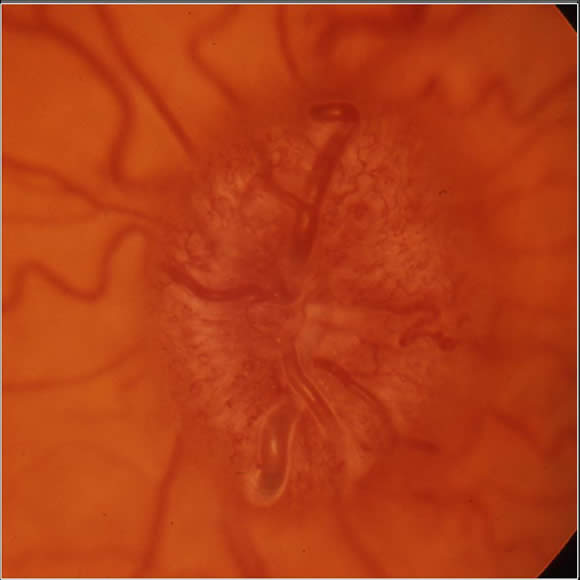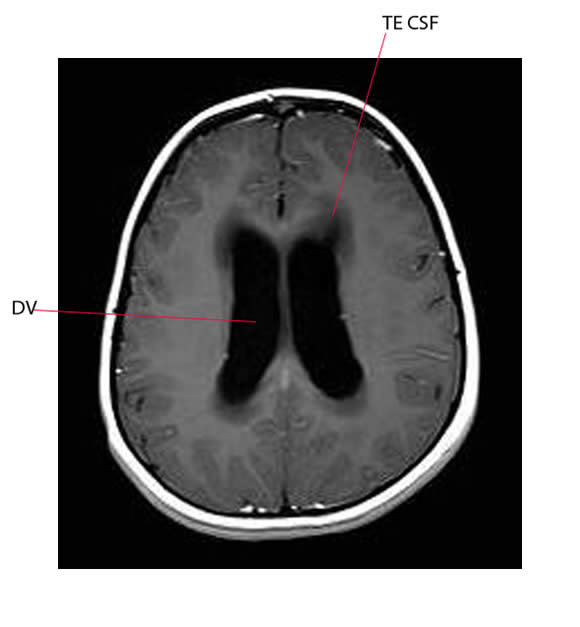Raised Intracranial Pressure (ICP)
Brain tumors are the most common solid malignancy seen in children and commonly present with raised intracranial pressure (hydrocephalus).
Hydrocephalus can be defined in terms of two broad "functional" categories:
- Communicating:
- The flow of CSF is blocked after it exits the ventricles (the ventricles are still open and communicating)
- Non-communicating:
- Also called "obstructive" hydrocephalus
- The flow of CSF is blocked along one or more of the narrow passages connecting the ventricles inside the brain
- Posterior fossa tumors are common in children and usually present with obstructive hydrocephalus due to the blockage of normal flow of cerebrospinal fluid at the level of the 4th ventricle
Pediatric brain tumors are associated with non-communicating (obstructive) hydrocephalus. Different causes of this include:
- Mass blocking the flow of CerebroSpinal Fluid
(CSF).
- Usually at the level of the 3rd or 4th ventricle.
- Disseminated subarachnoid tumor
- Infection - abscess
- Massive cerebrovascular bleed
- Blocked shunt
- Pseudotumor cerebri (acute promyelocytic leukemia treated with ATRA).
Symptoms and Signs:
Signs and symptoms of raised intracranial pressure depend on the age of the child.
Young babies and toddlers:
- Irritability and lethargy
- Loss of previously acquired motor skills
- Personality change and head banging
- Increased head circumference and prominent scalp veins
Older children and adolescents:
- Headache
- occipital
- worse early in morning
- worse coughing
- associated with vomiting
- Double vision
- unilateral or bilateral VI nerve palsy.
- the VIth (6th) cranial nerve has a long intracranial course and is therefore vulnerable to pressure. This is a "false localizing sign"
- On examination
- early blurred disc margins
- late papilledema
Cushing's triad - ominous signs for brainstem herniation:
- abnormal respirations
- hypertension
- bradycardia
Papilledema: Indistinct margin of optic disc on retinal exam

Left lateral rectus (VIth cranial nerve palsy)

LUMBAR PUNCTURE SHOULD NEVER BE DONE IN A PATIENT WITH SIGNS OR SYMPTOMS OF RAISED INTRACRANIAL PRESSURE. This may precipitate herniation of the temporal uncus through the tentorium, compressing first the third nerve, then the midbrain, pons, medulla and finally the cerebellar tonsils and brain stem herniate through the foramen magnum. This can cause patient death.
Emergent CT should be done to exclude an intracranial mass lesion first
Imaging:

Above is a MR picture of hydrocephalus:
- DV points to a dilated lateral ventricle
- TE CSF points to transependymal flow of CSF seen in the periventricular regions
Treatment
If the patient is reasonably well and not obtunded, initial therapy would be:
- Dexamethasone (1 - 2mg per kg once and then 0.25 - 0.5 mg/kg every 6 hours).
Herniation:
The patient becomes obtunded then death may quickly ensue. Initial therapy would be:
- Mannitol (1 - 2 g per kg over 30 - 60 minutes given IV)
- Intubation - mild hyperventilation
Brain Herniation on line resource by Greg Petermann and James G. Smirniotopoulos
Brain Herniation CNS response to injury

